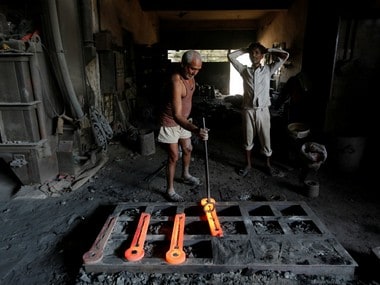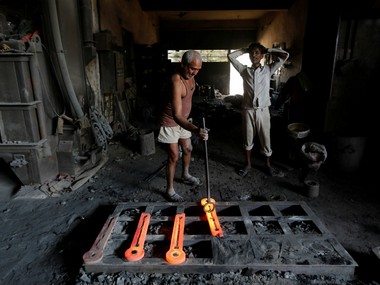The public discourse and expert discussion on India’s current economic slowdown is reminiscent of a central theme in the 1970 Kannada film Samskara (The Ritual). The Brahmin priests in a village are debating the appropriate manner to conduct funeral rites of a disreputable character, even as the corpse progressively rots and raises a stink. Similarly, discussions in India cover cyclical versus structural slowdowns. A few economists—including those from the government—argue that it is cyclical, part of the business cycle and is the outcome of seasonal factors. However, it will soon be reversed. Others claim that it is structural, that the underlying nature of the Indian economy has changed, and requires deep-seated structural reforms. Yes, the government has rolled back corporate tax increases (that shouldn’t have been increased in the first place) and announced a slew of other measures to incentivise exports . It has even encouraged state-owned banks to lend , though with little success; banks are carrying on with too many non-performing assets (NPAs) on their books resulting in heavy losses. [caption id=“attachment_4391191” align=“alignleft” width=“380”]  Representational image. Reuters.[/caption] The government’s cause hasn’t been helped by its rather confusing communications on policy matters. Consider what the vice-chairman of NITI Aayog (the government think-tank) Rajiv Kumar said in July this year; he called for policy interventions in specific industries to check what he called the worst economic slowdown in 70 years. The chief economic adviser (CEA) K Subramanian disagreed and argued for reforms to land and labour markets instead. Other people, like members of Prime Minister Narendra Modi’s economic advisory council, wrote op-eds with divergent views on what reforms were needed. All of which makes for great political spectacle, but is of not much help when it comes to making difficult economic choices for companies, investors and the public.
What is missing in the government’s narrative? Credibility. Think of it as ‘behavioural economics’ in action.
The corporate sector, investors and individuals will act if they believe that the government’s proposed structural reforms will deliver change and growth that is sustained; in other words, if momentum becomes visible over the next four quarters, for instance. To that end, here are three things that the government can do. Stop talking about India’s ‘strong economic fundamentals’ and the ‘potential growth rate’ of the economy: Macroeconomic fundamentals—strong fiscal consolidation, a low current account deficit, low inflation, urban consumption—are all weak actually. Growth has been at its lowest in 25 quarters and has been declining for the last six quarters. Inflation is beginning to rise, consumption (in rural India, too) is declining, and the current account deficit (CAD) is widening. Unemployment is at its highest-ever level in decades, and job creation has been negligible for the last three years. Potential GDP is a concept (not an aspiration) that aims to show what output would be when all cylinders of the economy are firing. In other words, potential GDP is what we could achieve if the economy was using all available resources, at full capacity. It’s basically a theoretical construction, even an assumption. The gap between potential and actual GDP—the output gap—is what the Reserve Bank of India (RBI) uses to determine if the economy needs a monetary stimulus (the RBI cut its policy rate by 135 basis points over the last year). Address the massive debt overhang: As a nation—government, businesses and households— we have a debt problem. Government and RBI data show that public debt amounted to a little over 68 percent of GDP at the end of 2018; corporate debt amounted to about 55 percent. Household debt as a percentage of GDP is nearly 12 percent, bringing the total debt to GDP ratio for India at 137 percent. For debt sustainability, two indicators matter. One is the ratio of interest payments to revenue receipts, which in FY18 went up to 35 percent. It is currently at that level. The second is average interest cost, which should be below nominal GDP growth. The average interest cost is about 7.2 percent. When nominal GDP growth is in the 12 percent range, that seems fine; recently, however, nominal GDP growth has been closer to 9 percent. That should be worrying. In a December 2018 working paper by the Asian Development Bank, the authors found that in the 20-year period from 1996-2016, increases in private corporate debt after a financial peak—the highest point of GDP growth—had a negative impact on investment and output growth; corporations were simply replacing high-cost debt with lower-cost debt. Much more importantly, the authors found that rapid corporate debt growth poses a greater risk of precipitating crisis. Corporate India’s debt problems are all too well-known; in sector after sector (the latest is telecom), news headlines raise regularly warnings about high debt levels that have, and will, impose huge costs on the financial system.
What we have seen so far is a blood-letting, analysts say; soon, a bloodbath will follow. Just look at what is happening with the banks and non-bank finance companies. Thus far, the government has refrained from monitoring corporate debt (though the RBI does). Perhaps it’s time the Ministry of Corporate Affairs (MCA) took an interest too.
Household debt has grown very rapidly; data from the RBI’s Handbook of Statistics on the Indian Economy, and a September 2019 State Bank of India (SBI) research note found that total household debt was Rs 7.64 lakh crore, an increase of 58 percent from FY14 to FY18. Household savings, by contrast, grew by just 18 percent in that same period. Household savings have declined; Central Statistical Organisation (CSO) data show that gross savings fell from 34.6 percent of GDP in FY12 to 30.5 per cent in FY18. The RBI’s 2017 report on India Household Finance added some more insights from the 2013 All India Debt and Investment Survey (AIDIS). The average Indian household holds 77 percent of its assets in real estate, 11 percent in gold, 5 percent in financial assets and almost nothing in pensions or retirement savings. The structure of the average household’s liabilities is made up of mortgages at 23 percent, gold loans account for roughly 7 percent and 15 percent in other forms of secured debt. Unsecured debt makes up about 55 percent of a household’s liabilities. This significant reliance on unsecured is particularly noticeable among younger age groups. Household financial vulnerability is thus particularly acute: unsecured debt is usually high cost, and the very low stock of liquid financial assets can put households into financially untenable positions. The distance from financial comfort to financial crisis is a very short one, especially in an extended economic slowdown. Address the quality of government expenditure. It is an accepted and widely held axiom that the higher the quality of expenditure, the better the economic growth outcomes. The most basic division of public expenditure is revenue and capital expenditure. The former creates productive assets, the latter pays bills: salaries, pensions, subsidies, and interest. The Union Budget documents show that from FY17 to FY20, capital expenditure allocation went up by 18 percent over four years; revenue expenditure went up by 45 percent in that same period: nearly 2.5 times more. In that same period, the Union Budget used ‘extra-budgetary resources’; essentially, the government borrowed on the strength of the balance sheets of public sector enterprises while keeping that debt out of the fiscal deficit calculations.
If you thought that extra-budgetary resources (EBR) was to finance capital expenditure—which would be appropriate—think again. EBR borrowing began exceeding capital expenditure outlays. Investment to GDP ratio cannot improve if the government does not invest, and takes the sales of equity in PSUs (a capital asset) but uses it as revenue expenditure. That is unsustainable.
The upcoming Union Budget for FY21 is an opportunity to do demonstrate its intent to rebuilding its economic policy credibility. Carpe Diem, in other words. Otherwise, we will go from being the fastest growing economy in the world back to the old ‘Hindu rate of growth’ in a very short time. (The writer is a former journalist and communications consultant).


)
)
)
)
)
)
)
)
)



